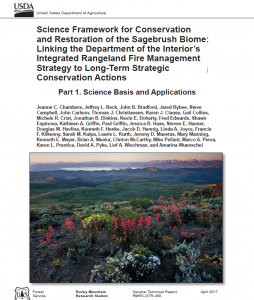Synthesis / Tech Report
This report provides a framework for assessing cross-boundary wildfire exposure and a case study application in the western US. The case study provides detailed mapping and tabular decision support materials for prioritizing fuel management investments aimed at reducing wildfire exposure to communities located proximal to national forests. We used national FSim simulation outputs to (1) estimate cross-boundary wildfire among major land types (Federal, State, private); (2) quantify structure exposure to all western communities; (3) map sources of community wildfire exposure (firesheds); (4) characterize firesheds in terms of management opportunity and fuels; and (5) prioritize communities based on integration of exposure and fireshed characteristics.
View report.
Wildland firefighters in the United States are exposed to a variety of hazards while performing their jobs in America’s wildlands. Although the threats posed by vehicle accidents, aircraft mishaps, and heart attacks claim the most lives, situations where firefighters are caught in a life-threatening, fire behavior-related event (i.e. an entrapment) constitute a considerable danger because each instance can affect many individuals. In an attempt to identify the scope of understanding of the causes of firefighter entrapments a review of the pertinent literature and a compilation and synthesis of existing data were undertaken.
View report.
Scientists at the Southern Research Stations of the US Forest Service combined the hydrometeorological and fire data for 168 fire-affected areas in the contiguous United States collected between 1984 and 2013. This enabled them to determine when wildland fires can affect the annual amount of flow in rivers, and to create a suite of climate and wildland fire impact models adapted to local conditions.
View the infographic.
View the Forest Service Bulletin summary.
View a list of information and tools for applying these concepts.
View the executive summary.
The Science Framework for Conservation and Restoration of the Sagebrush Biome is a two-part guide to managing sagebrush ecosystems in the West and was developed by an extensive interagency team of scientists and managers. It uses the concepts of resilience to disturbance (ability to recover) and resistance to invasive annual grasses across three geographic scales (sagebrush biome, ecoregions, and local sites) to prioritize conservation and restoration actions in areas where they are likely to have the greatest benefits.
Part 1 provides the science basis and decision-support tools for prioritizing areas and strategies for management.
Part 2 focuses on management considerations and tradeoffs for applying the information in Part 1, including monitoring and adaptive management, climate adaptation, wildfire and vegetation management, nonnative invasive plant management, application of National Seed Strategy concepts, livestock grazing management, and wild horse and burro considerations.
View report.
This collection of essays—divided into three key categories: Risk, Culture, and Operations—daylights qualities and practices in the wildland fire service across a broad spectrum, from outdated and unwarranted to honorable and profound. We must acknowledge our current culture and its shortcomings while using its strengths to lead change.
View report.
Sage grouse and many other species rely on a range of mesic habitats—including riparian areas, wet meadows, alfalfa fields, and productive rangelands—to sustain their populations. Landscapes with the greatest uncertainty in mesic abundance and distribution support the fewest grouse.
View report.
This collection represents collective insight into how we operate and why we must alter some of our most ingrained practices and perspectives.
View synthesis.
This report synthesizes our current knowledge on mastication as a forest management tool. We found that excavators, skid steers, and tractors can all be carrier machines and different types of vertical and horizontal cutting heads exist that can be front-end mounted or boom mounted, each with its own advantages and disadvantages. We provide a summary on the ecological effects from mastication. We found that there were several studies on plant and soil impacts, but limited information on impacts to wildlife habitat. Although costs of mastication widely vary depending on machine size, the physical setting, size and configuration of pre-treatment biomass, and operator skill, mastication does have market and non-market benefits. Depending on the management objective, if mastication is an option, then a thorough site evaluation should consider slope, nonnative species invasions, vulnerability of soils to erode or compact, and treatment costs.
Read UT Conservation Plan.
This Plan identifies strategies to address localized threats to sage-grouse populations in Utah. Those strategies include—but are not limited to—the following:
- Identify the highest-priority sage-grouse habitats and migration corridors, and protect at least 5,000 of those acres annually through conservation easements, or other mechanisms.
- Improve and increase sage-grouse seasonal habitats by 75,000 acres each year, including riparian and mesic habitats.
- Monitor sage-grouse population trends annually and, if necessary, implement adaptive management responses to ensure that priority populations remain viable and stable.
- Coordinate with local, state and federal firefighting jurisdictions to include sage-grouse habitats as a priority during pre-fire attack planning and suppression, second only to the protection of human life and property.
- Fund, support and implement critical research that supports the implementation of this Plan.
The Revegetation Equipment Catalog provides provides descriptions, applications, photos, and vendors of equipment used for seed collection and cleaning, site preparation, revegetation, and vegetation management.



